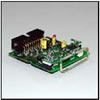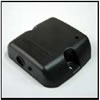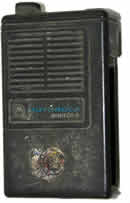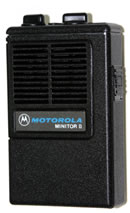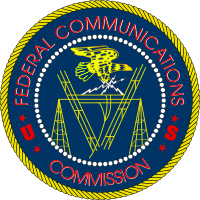BloostonLaw Telecom Update Published by the Law Offices of Blooston, Mordkofsky, Dickens, Duffy & Prendergast, LLP [Portions reproduced here with the firm's permission.] www.bloostonlaw.com |
| Vol. 13, No. 18 | April 28, 2010 |
 CenturyLink To Acquire Qwest Communications CenturyLink and Qwest Communications have announced that their boards of directors have approved a definitive agreement under which CenturyLink will acquire Qwest in a tax-free, stock-for-stock transaction. Under the terms of the agreement, Qwest shareholders will receive 0.1664 CenturyLink shares for each share of Qwest common stock they own at closing. Upon closing of the transaction, CenturyLink shareholders are expected to own approximately 50.5% and Qwest shareholders are expected to own approximately 49.5% of the combined company. Based on the closing stock price of CenturyLink on April 21, the per share consideration to be received by Qwest shareholders would be equivalent to $6.02 of CenturyLink stock, which represents a premium to Qwest shareholders of approximately 15% over Qwest’s closing stock price on April 21. Based on the closing stock price of CenturyLink on April 21, the transaction reflects an enterprise value of Qwest of approximately $22.4 billion, including the assumption of $11.8 billion of Qwest net debt outstanding as of December 31, 2009. The transaction is expected to generate annual operating and capital synergies of approximately $625 million when fully recognized over a three- to five-year period following the close of the transaction. This combination is expected to result in a company whose enterprise business will be a significant contributor to its growth which, along with the consumer business, will allow it to offer innovative broadband products and services over its advanced networks. As of December 31, 2009, CenturyLink and Qwest served local markets in 37 states with approximately 5 million broadband customers, 17 million access lines, 1,415,000 video subscribers and 850,000 wireless consumers. BloostonLaw contacts: Hal Mordkofsky, Ben Dickens, Gerry Duffy, and John Prendergast. |
 INSIDE THIS ISSUE - Text of USF NPRM focuses on reforming cap growth.
- FCC adopts Notice of Inquiry on cyber security issues.
- NTIA announces nine BTOP grants worth $114 million.
- FCC sets dates for FNPRM on roaming obligations for data, broadband services.
- FCC acts on cablecard item.
- FCC study backs agency’s cost models.
|
Text of USF NPRM Focuses On Reforming Cap Growth At its April 21 open meeting, the FCC adopted a Universal Service Notice of Inquiry and Notice of Proposed Rulemaking (NPRM). In general, the NOI focuses on whether the Commission should use a model to help determine universal service support levels in areas where there is no private sector business case to provide broadband and voice services. The NPRM focuses on specific reforms to cap growth and cut “inefficient” funding in the legacy high-cost support mechanisms and to shift the savings toward broadband communications. Our focus here is on the text of the NPRM. It will be vital for our ILEC clients (and others) to participate in this rulemaking process, as the FCC seeks to redirect USF to other purposes while capping the size of the fund, creating an environment that can prove detrimental to the ability or rural carriers to maintain and expand the incumbent network that is a vital link for rural broadband traffic. Controlling the Size of the High-Cost Program Here is the FCC’s explanation of the NPRM’s goals: As an essential first step toward repurposing the Universal Service Fund (USF) to support broadband as well as voice service, the FCC believes it must ensure that the size of the fund remains reasonable. The National Broadband Plan recommends that the Commission take steps to manage the USF so that its total size remains close to its current level (in 2010 dollars) to minimize the burden of increasing universal service contributions on consumers. The Commission already has taken action to control the overall size of the high-cost fund. In 2008, the Commission adopted on an interim basis an overall competitive eligible telecommunications carrier (ETC) high-cost cap of approximately $1.4 billion, pending comprehensive USF reform. Similarly, the FCC seeks comment on capping legacy high-cost support provided to incumbent telephone companies at 2010 levels, which would have the effect of creating an overall ceiling for the legacy high-cost program. Such a cap would remain in place while the Commission determines how to distribute funds in a “more efficient, targeted manner” to those areas of the country where no firm can operate profitably without government support, while minimizing burdens on American consumers who ultimately pay for universal service through carrier pass-through charges. The FCC seeks comment on how the Commission could implement such a cap. Alternatively, the FCC invites other proposals that would ensure that the overall size of the high-cost fund stays at or below current levels. Should the Commission impose an overall cap on legacy high-cost support for incumbent local exchange carriers (LECs) at 2010 levels? Should the Commission impose a cap on each individual high-cost mechanism (to the extent each is not already capped) at 2010 levels? Should the Commission freeze per-line support for each carrier at 2010 levels? For example, the Alliance for Rural CMRS Carriers proposed that incumbent LEC support amounts per line be capped at either March 2008 or March 2010 levels. The FCC seeks comment on this proposal. Alternatively, should the Commission freeze the total amount of support a carrier receives in a particular study area at 2010 levels? Are there other ways to implement such a cap? What rule changes would be required to implement this proposal? How would the Commission implement this proposal in conjunction with the reforms identified in the following paragraphs? In addition, what implications would this proposal have for other Commission rules, such the Commission’s current pricing rules, and should the implementation of this proposal be coordinated with any other regulatory actions? Specific Steps to Cut Legacy High-Cost Support The National Broadband Plan identifies several specific first steps that could reduce funding in the legacy high-cost support mechanisms and recommends that those savings be used to further the goals of universalizing broadband without increasing the overall size of the universal service fund. The National Broadband Plan recognizes that shifting funds could have transitional impacts and recommends that “[a]s the FCC considers this policy shift, it should take into account the impact of potential changes in free cash flows on providers’ ability to continue to provide voice service and on future broadband network deployment strategies.” The FCC seeks comment on the first steps set forth in the National Broadband Plan. To the extent that any commenter believes that these proposals, or the proposal to cap legacy high-cost support, would negatively affect affordable voice service for consumers today, the FCC would encourage such a commenter to identify all assumptions and to provide data, including information on network investment plans over the next five years and free cash flows, to support that position. The intent of these proposals is to eliminate the indirect funding of broadband-capable networks today through legacy high-cost programs, which is occurring “without transparency or accountability for the use of funds” to extend broadband service. The FCC seeks comment on the timing of implementing such reforms in conjunction with the creation of a more efficient and targeted framework that will provide support for broadband and voice. The FCC encourages commenters to address when each rule change should be implemented and how specific reforms should be sequenced to provide regulatory clarity for on-going private sector investment. In addition, the FCC seeks comment on the relationship between such universal service reforms and carriers’ rates, including intercarrier compensation rates, under the Commission’s current pricing rules. The FCC seeks comment both on the likely rate impacts under existing pricing rules that would arise from the possible universal service reforms and any appropriate responses. The FCC also notes that many rural rate-of-return carriers participate in the National Exchange Carrier Association (NECA) pooling process for their interstate access charges. If universal service support under the legacy programs were frozen for such carriers, are there special considerations resulting from operation of the NECA pool that would unfairly advantage or disadvantage certain carriers? The Commission previously has expressed concern about the risks of continued participation in NECA pools by carriers that were subject to incentive regulation. The FCC seeks comment on whether such concerns would remain if all rate-of-return carriers converted to incentive regulation. Would the pool be able to continue to operate pursuant to regulation other than rate-of-return? Shifting Rate-of-Return Carriers to Incentive Regulation. The National Broadband Plan recommends that the Commission “require rate-of-return carriers to move to incentive regulation.” The FCC seeks comment on requiring current rate-of-return companies to convert to some form of incentive regulation. The FCC notes that a number of companies have voluntarily converted to price cap regulation in the last two years. In such cases, the Commission effectively converted the companies’ interstate common line support (ICLS) to a frozen amount per line. The FCC seeks comment on whether the Commission should replace rate-of-return regulation with the price-cap framework recently adopted for voluntary conversions, an alternative price-cap framework, or some other form of incentive regulation. The FCC seeks comment on the costs and the benefits that would be realized by converting all rate-of-return carriers to price cap regulation or other incentive regulation. The FCC seeks comment on whether, in an increasingly competitive marketplace, and with carriers’ service offerings expanding beyond regulated services, the current rate-of-return framework, which considers only regulated costs and revenues, has become less appropriate. The FCC seeks comment on whether it should convert ICLS to a frozen amount per line, which would have the effect of limiting growth in the legacy high-cost program. The FCC seeks comment on whether this reform should be implemented at the same time as any measures the Commission may adopt to provide targeted funding for the deployment of broadband-capable infrastructure to areas that are unserved, or should such a rule change occur before the development of the Connect America Fund (CAF), or otherwise be coordinated with some other regulatory action such as conversion to incentive regulation. The National Broadband Plan recognizes that the savings realized by eliminating future growth in the legacy ICLS program represent funding that could be redirected toward achieving broadband-related goals. The FCC seeks comment on this proposal. Elimination of Interstate Access Support. The National Broadband Plan also recommends that the Commission “redirect access replacement funding known as Interstate Access Support (IAS) toward broadband deployment.” Thus, it now seeks comment on the elimination of interstate access support. When the Commission created IAS in 2000, it said that it would revisit this funding mechanism “to ensure that such funding is sufficient, yet not excessive.” That reexamination has not occurred. Specifically, the FCC now seeks comment on eliminating sections 54.800-54.809 of its rules and transferring any IAS funding levels as of the date of elimination to the new Connect America Fund to provide support for broadband-capable networks. The FCC invites commenters to propose an appropriate timeline for the elimination of these rules and any glide-path that may be necessary to ensure that recipients continue to be able to provide voice services during the transition. Sprint and Verizon Wireless Voluntary Commitments. The National Broadband Plan also recommends that the Commission “issue an order to implement the voluntary commitments of Sprint and Verizon Wireless to reduce the high-cost funding they receive as competitive eligible telecommunications carriers to zero over a five-year period as a condition of earlier merger decisions.” The Commission will consider shortly an order clarifying how to implement Verizon Wireless’s and Sprint’s voluntary commitments. Elimination of Competitive ETC High-Cost Support. The National Broadband Plan recommends that the Commission phase out remaining competitive ETC funding under the existing funding mechanisms over a five-year period and target the savings toward the deployment of broadband capable networks and other reforms in the plan. The FCC seeks comment on this proposal. The FCC seeks comment on whether it should ramp down competitive ETC support under the legacy programs, and if so, how the transition should occur. For example, should the Commission reduce support on a pro rata basis (e.g., 20% reduction each year) for each state? Should the Commission reduce support at an accelerated rate of decline? Should the Commission reduce support on a proportional basis for all states, or in some other manner, and if so, on what basis? Would there be any impact on existing subscribers of competitive ETCs if the Commission were to reduce competitive ETC support under the legacy funding mechanisms? How should reductions in legacy high-cost support for all competitive ETCs be coordinated with implementation of Verizon Wireless’s and Sprint’s voluntary commitments to phase-out legacy high-cost support over a five year period? General Proposals. Commenters are invited to submit other proposals to eliminate or reduce funding levels in the legacy high-cost support mechanisms to transition to efficient funding levels in the Connect America Fund. The FCC encourages parties that submit alternative proposals to identify specific rule changes and quantify the impact of such changes. Comments in this WC Docket No. 10-90, GN Docket No. 09-51, and WC Docket No. 05-337 proceeding will be due 60 days after publication of the item in the Federal register, and replies will be due 30 days thereafter. BloostonLaw contacts: Ben Dickens, Gerry Duffy, and Mary Sisak. FCC Adopts Notice of Inquiry On Cyber Security Issues The FCC, at its April public meeting, adopted a Notice of Inquiry (NOI) that seeks comment on the proposed creation of a new voluntary cyber security certification program that would encourage communications service providers to implement a full range of cyber security best practices. In 2008, the FCC said, a Data Breach Investigations report concluded that 87% of cyber breaches could have been avoided if reasonable security controls had been in place. The goals of a voluntary cyber security certification program would be to: - Increase the security of the nation’s communications infrastructure;
- Promote a culture of more vigilant cyber security among participants in the market for communications services; and
- Offer consumers (or end-users) more complete information about their communication providers’ cyber security practices and ability to better protect their personal computer hardware and online activity from cyber attacks.
The NOI seeks comment on a voluntary certification program under which private sector auditors or the FCC would conduct security assessments of participating communications service providers’ networks, including their compliance with stringent cyber security practices developed by a broad-based public-private partnership. Providers whose networks successfully completed this assessment would then be able to market their networks as complying with these FCC network security requirements. Further, the NOI includes the following questions regarding the proposal: - The benefits and costs of such a program.
- Whether such a program will create a significant incentive for providers to increase the security of their systems and improve their cyber security practices.
- Whether public knowledge of providers’ cyber security practices would contribute to broader implementation by industry.
- Whether the scope of the certification program should be open to all communications service providers or should be limited to certain types of providers. If the latter, how should this be limited?
- What the overall framework should be for the certification criteria.
- The composition of a certification authority and whether it should be open to all segments of the potentially affected industries.
- The operating procedures of a certification authority.
- Who should be responsible for establishing the requirements that auditors must meet to be accredited to conduct cyber security assessments under the proposed program?
- What should be the appropriate certification criteria, accreditation procedures, and requirements to maintain certification once obtained?
- Whether the network security criteria should be definitive and objectively measurable or established on a case-by-case basis.
- The development and application of assessment standards.
- The form and duration of the security certificate, the renewal process, and permissible uses by providers of the security certificate.
- How appeals of certification issues should be handled.
- Whether any Commission enforcement process should be implemented for this program.
The NOI seeks comment on other actions, including voluntary incentives the Commission can take to improve cyber security and asks about actions the Commission can take to better educate consumers, businesses and government agencies about cyber security. Comments in this PS Docket No. 10-93 proceeding will be due 60 days after publication of the item in the Federal Register, and replies will be due 60 days thereafter. BloostonLaw contacts: Hal Mordkofsky, Ben Dickens, Gerry Duffy, and John Prendergast. NTIA Announces Nine BTOP Grants Worth $114 Million The National Telecommunications and Information Administration (NTIA) has announced nine American Recovery and Reinvestment Act Broadband Telecommunications Opportunities Program (BTOP) grants: Multiple states: One Economy Corporation: $28.5 million sustainable broadband adoption grant with an additional $23 million applicant-provided match to implement a comprehensive program of computer training, wireless Internet access, broadband awareness marketing, and online content and applications to residents of 159 affordable and public housing developments and low-income communities in 50 cities and towns across 31 states and the District of Columbia. States impacted by this grant are: Alabama, Arkansas, California, Connecticut, District of Columbia, Florida, Georgia, Illinois, Indiana, Kentucky, Massachusetts, Maryland, Michigan, Minnesota, Missouri, Nevada, New Jersey, New Mexico, New York, North Carolina, Ohio, Oklahoma, Oregon, Pennsylvania, Rhode Island, South Carolina, South Dakota, Tennessee, Texas, Virginia, Washington, Wisconsin. Idaho: Digital Bridge Communications: $1.9 million broadband infrastructure grant with an additional $466,000 applicant-provided match to bring affordable wireless broadband service to rural, underserved communities in Cassia County, Idaho, including the towns of Albion, Burley, Declo, Malta, and Oakley. The project would expand Digital Bridge Communications’ existing network by adding five towers, 46 miles of new fiber, and a nine-mile microwave link. The project also proposes to offer speeds of up to 3 Mbps using both fixed and mobile wireless technology, as well as directly connect approximately 25 community anchor institutions at no charge. Idaho: Digital Bridge Communications: $980,000 broadband infrastructure grant with an additional $246,000 applicant-provided match to bring affordable wireless broadband service to rural, underserved communities in Jerome County, Idaho, including the towns of Barrymore, Falls City, Greenwood, Haytown, Hunt, Hydra, Jerome, McHenry, and Sugar Loaf. The project would expand Digital Bridge Communications’ existing network by adding three towers, 15 miles of new fiber, and two microwave links. The expanded network intends to offer speeds up to 3 Mbps using both fixed and mobile wireless technology, as well as directly connect approximately 25 community anchor institutions at no charge. Idaho: Digital Bridge Communications: $1.4 million broadband infrastructure grant with an additional $340,000 applicant-provided match to bring affordable wireless broadband service to underserved communities in Twin Falls County, Idaho, including the towns of Buhl, Burger, Clover, Deep Creek, Fairview, Filer, Godwin, and Hansen. The project would expand Digital Bridge Communications’ existing network by adding eight towers, three miles of new fiber, and nine microwave links. This expanded network intends to offer speeds up to 3 Mbps using both fixed and mobile wireless technology, as well as directly connect approximately 25 community anchor institutions at no charge. Kentucky: City of Williamstown, Kentucky: $535,000 broadband infrastructure grant with an additional $134,000 applicant-provided match to deploy a high-speed fiber-to-the-home broadband network to unserved and underserved communities south of its existing network in Corinth, and north of its existing network to areas of Grant and Owen counties in northern Kentucky. The project intends to offer broadband speeds up to 10 Mbps and directly connect the three municipal organizations within the service area – Corinth City Hall, the Corinth Water District, and the Corinth Volunteer Fire Department – free of charge. In addition, the project expects to offer broadband Internet access for local consumers, including approximately 680 households and 20 businesses, and spur economic growth and job creation in the region. Oklahoma: Pine Telephone Company, Inc.: $9.5 million broadband infrastructure grant with an additional $2.4 million applicant-provided match to deliver affordable wireless broadband service to underserved areas of Southeastern Oklahoma, including the Tribal lands of the Choctaw Nation and its 10 counties. The project intends to directly connect 20 community anchor institutions, including Choctaw Nation agencies, public schools, public safety agencies, fire and police departments, and a health clinic. The project’s last mile network plans to offer broadband speeds ranging from 1 Mbps to 3 Mbps to as many as 7,000 households and 75 businesses. Puerto Rico: Critical Hub Networks, Inc.: $25.8 million broadband infrastructure grant with an additional $6.7 million applicant-provided match to provide fast, affordable broadband connectivity for last-mile Internet service providers and underserved areas of Puerto Rico, including of the islands of Culebra and Vieques. The project plans to purchase a 10 Gbps undersea fiber-optic cable directly connecting to Miami and deploy more than 180 miles of terrestrial middle-mile microwave network using 11 towers. The network will offer speeds from 100 Mbps to 1 Gbps to anchor institutions, including more than 1,500 K-12 schools, and local Internet service providers. Virginia: Buggs Island Telephone Cooperative: $19 million broadband infrastructure grant with an additional $5 million applicant-provided match to bring high-speed affordable broadband services to 15 underserved counties and the cities of Emporia and Franklin in South Central Virginia by expanding and enhancing its existing high-speed broadband and voice communications wireless network. The BIT Wireless project intends to offer wireless broadband at speeds of up to 10 Mbps to as many as 100,000 households, 14,800 businesses, and 800 community anchor institutions. In addition, the project will promote broadband adoption by discounting the cost of the equipment necessary to subscribe at home. Washington: Public Utility District of Pend Oreille County: $27.2 million broadband infrastructure grant with an additional $6.8 million applicant-provided match to bring high-speed, affordable broadband to underserved areas of Pend Oreille County in northeastern Washington State, which borders Idaho and Canada. The proposed fiber-to-the-premises network would deploy approximately 526 miles of fiber-optic cable to deliver last-mile broadband Internet services and facilitate critical network redundancy in this rural area. The project plans to offer affordable, high-speed broadband access to as many as 3,200 households, 360 businesses, and 24 community anchor institutions. BloostonLaw contacts: Hal Mordkofsky, Ben Dickens, Gerry Duffy, John Prendergast, and Mary Sisak. FCC Sets Dates For FNPRM On Roaming Obligations For Data, Broadband Services The FCC has established a comment cycle for its Second Further Notice of Proposed Rulemaking (FNPRM) on whether to extend roaming obligations to data services that are provided without interconnection to the public switched network—including mobile broadband services. The Commission adopted this item at last week’s open meeting (BloostonLaw Telecom Update, April 21). Comments in this WT Docket No. 05-265 proceeding are due June 14, and replies are due July 12. In the Second FNPRM, the Commission seeks additional comment on whether to extend automatic roaming obligations to certain mobile data services—specifically, mobile services, including mobile broadband Internet access, that are provided without interconnection to the public switched telephone network. The Commission is seeking comment as well on whether any such obligations should apply only to service providers that are also commercial mobile radio service (CMRS) carriers or more broadly to facility-based mobile data service providers whether or not they also provide CMRS. The Commission's underlying policy goals remain the same as for mobile voice service roaming—to facilitate the provision of services in a manner that provides the greatest benefit to consumers. In particular, the Commission seeks to have service provided by new entrants in competition with established incumbents; to ensure that consumers have access to seamless coverage nationwide; and to provide incentives for both new entrants and incumbent service providers to invest and innovate by using available spectrum and constructing wireless network facilities on a widespread basis. The Commission invites parties to include any new information that may be relevant to the Commission's consideration of what action, if any, may be appropriate in this proceeding. BloostonLaw contacts: Hal Mordkofsky, John Prendergast, and Cary Mitchell. FCC ACTS ON CABLECARD ITEM: The FCC has issued a Notice of Inquiry (NOI) and a Fourth Further Notice of Proposed Rulemaking (FNPRM) to (1) create a competitive retail market for navigation devices for use with multichannel video programming distributors (MVPDs); and (2) propose changes to the current CableCard system to make it more consumer-friendly while a new technology approach is being developed. According to the FCC, consumers are increasingly accessing video from multiple sources, including MVPD services, the Internet, DVDs, and over-the-air broadcasting. The NOI seeks input on ways to foster a more competitive marketplace for navigation devices and in particular calls for comment on a standardized interface that enables smart video devices to bring video from all of these sources together for ease of selection, recording, and viewing. The standardized interface could be implemented through an “AllVid” adapter that would act as an intermediary between the consumer’s device and the MVPD’s service. The service provider would be free to innovate within its network to improve its services, without requiring replacement of the consumer’s home devices. And a consumer could switch from one provider to another and continue to use the same smart video devices. The FCC says the FNPRM proposes to remedy shortcomings in the existing CableCARD system, to provide consumers with better service in the interim before the new AllVid approach is in place. In order to remove the disparity between consumers who choose to use a retail Cable-CARD-equipped video device and those who lease a cable provider’s video navigation box, the proposed interim measures would: (1) ensure that retail devices have comparable access to video programming that is prescheduled by the programming provider; (2) make CableCARD pricing and billing more transparent; (3) streamline CableCARD installations; and (4) clarify certification requirements. Comments on the Notice of Inquiry (FCC 10-60) MB Docket No. 10-91; CS Docket No. 97-80; PP Docket No. 00-67 will be due 60 days after publication in the Federal Register and replies will be due 30 days thereafter; comments on the FNPRM will be due 30 days after publication, and replies will be due 15 days thereafter. BloostonLaw contact: Gerry Duffy. FCC STUDY BACKS AGENCY’s COST MODELS: The FCC has released a white paper study that builds on the National Broadband Plan recommendations to create what it calls “an economically viable, technically sound, and robust interoperable public safety wireless broadband network across America.” Titled A Broadband Network Cost Model: The Basis for Public Funding Essential to bringing Nationwide Interoperable Communications to America’s First Responders, the study offers a detailed analysis of how the FCC's plan for creation and funding of the network would meet public safety’s needs for accessibility, reliability, and affordability, while saving the nation approximately $18 billion or more in capital and operating expenditures over a 10-year period. The plan would also ensure true interoperability for public safety across the nation, stretching beyond large cities and metropolitan areas and into rural America. The FCC study examines the merits of the Plan's comprehensive strategy to create a nationwide interoperable public safety wireless broadband network for first responders and other public safety agencies that accounts for sufficient capacity on a day-to-day and emergency basis; ensures interoperability; and dedicates funding to the nationwide deployment of a resilient, redundant and robust network. A major highlight of the study’s analysis shows that the FCC's recommendation to capitalize on commercial network build-out at the same time the public safety network is created would cost approximately $6.5 billion over 10 years, significantly less than the projected $15.7 billion in capital costs associated with building a stand-alone public safety network. In addition, the FCC's analysis indicates that to build and operate a stand-alone public safety network would be substantially more expensive than a network constructed under the FCC’s recommended incentive-based approach. The study projects $12 to $16 billion in network costs for upgrades and operations within the first 10 years of the network’s existence, while the cost for a stand-alone public safety network over the same 10-year period is projected at $25 billion. Some primary reasons the costs increase exponentially for a stand-alone public safety network are: (1) public safety would not be able to easily leverage commercial resources and technologies associated with the build out of the network, (2) public safety could not capitalize on existing commercial cell sites and towers, and (3) public safety could not gain access to equipment, including portable radios, at commercially competitive prices. Conversely, the FCC's plan for an incentive-based partnership to build the public safety wireless broadband network would establish a public grant funding program to pay for capital and operating expenses and would build in incentives to enable public safety to leverage commercial technologies and resources. BloostonLaw contacts: Ben Dickens, Gerry Duffy, and Mary Sisak. FCC DOES NOT PROHIBIT STATES FROM COLLECTING DATA: The FCC has granted in part a petition for declaratory ruling filed by the National Association of Regulatory Utility Commissioners (NARUC) regarding State authority to collect data from broadband infrastructure and service providers. It concluded that the Commission has not preempted or otherwise precluded the States from mandating that broadband providers file data or other information regarding broadband infrastructure or services. In issuing this declaratory ruling, the FCC expressed no opinion regarding whether the laws of any particular State authorize the State’s public utilities commission or similar agency to require the filing of such data or information. Nor does the FCC address whether any State or group of States should, as a policy matter, engage in broadband data collection efforts that supplement ongoing federal efforts. In its petition, NARUC requested that the Commission “clarify that no FCC-issued order or regulation limits State authority to collect any data from any broadband infrastructure or service provider.” NARUC filed this request against the backdrop of the ongoing national effort to increase the deployment and adoption of broadband services. A critical element of this effort will be improving the quality and usefulness of data regarding broadband infrastructure and services. In particular, as Congress recognized in enacting the Broadband Data Improvement Act (BDIA) in October 2008, improved federal data on broadband deployment and adoption “will assist in the development of broadband technology across all regions of the country.” In enacting the BDIA, Congress recognized that a number of States were attempting to collect broadband-related data. Those efforts, however, typically rely on voluntary submissions from data-holders. This reliance on voluntary submissions has made it difficult, if not impossible, for any given State to obtain comprehensive and reliable information on broadband deployment and adoption within its borders. The record indicates that States accepted a voluntary submission regime in part because of uncertainty as to whether the Commission had preempted State broadband data collection efforts. NARUC filed its petition in order to eliminate this uncertainty. The petition points out that on July 22, 2009, NARUC adopted a resolution urging the Commission to issue a declaratory ruling that it “has not asserted any general preemption of any State actions requiring broadband service providers to submit specific information, at an appropriate level of granularity as determined by the State, on broadband service locations, speeds, prices, technology and infrastructure within the State . . . .” The petition asks that the FCC eliminate ambiguity regarding “the scope of existing State authority” to collect data from broadband infrastructure and service providers. Several parties supported this request. Other parties opposed NARUC’s request, arguing that NARUC’s petition incorrectly assumes both that the States have the authority to mandate the filing of broadband-related data and that it would be good public policy for the States to impose such a mandate. Under Section 1.2 of the Commission’s Rules, the Commission may issue a declaratory ruling either to terminate a controversy or to remove uncertainty. The Commission has broad discretion whether to issue such a ruling. The record reflects widespread uncertainty regarding whether the Commission has preempted the States from mandating the filing of broadband information. The record also makes clear that this uncertainty may impede State efforts to promote broadband deployment and adoption. The question is whether the Commission has exercised its delegated authority to preclude the States from undertaking mandatory broadband information collection efforts. The FCC concluded that the Commission has not preempted or otherwise precluded the States from mandating that broadband providers file data or other information regarding broadband infrastructure or services with the States. BloostonLaw contacts: Ben Dickens, Gerry Duffy, and Mary Sisak. FCC ESTABLISHES EMERGENCY RESPONSE INTEROPERABILITY CENTER: The FCC has established its new Emergency Response Interoperability Center (ERIC) under the Public Safety and Homeland Security Bureau (PSHSB). ERIC’s primary mission is to lead the development of a technical and operational framework that will support and foster nationwide operability and interoperability in wireless broadband communications for America’s first responders. One of the priorities for the FCC in opening this new center will be to establish a broadly representative Public Safety Advisory Board to serve in a central advisory role to the ERIC. In addition to public safety input, ERIC will work closely with industry, commercial providers, manufacturers and standards setting groups to ensure interoperability and operability on the new network. As broadband standards and technology evolve, the ERIC will adopt and implement: - Technical requirements and procedures for ensuring a nationwide level of interoperability;
- Mechanisms to address operability, roaming, priority access, gateway functions and interfaces, and inter connectivity of public safety broadband wireless networks; and
- Authentication and encryption requirements for common public safety broadband applications and network usage.
To better ensure a comprehensive and coordinated federal effort in the area of public safety broadband communications, the U.S. Department of Homeland Security (DHS) and the National Institute of Standards and Technology (NIST) will be instrumental in the functions of the ERIC. This collaboration will assist with ensuring that interoperability exists from the outset in the construction and operation of the public safety nationwide wireless broadband network in the 700 MHz band. DHS will participate in the areas of public safety outreach and technical assistance, as well as best practices development. NIST will participate in the areas of standards development, verification, testing and validation. BloostonLaw contacts: Hal Mordkofsky, John Prendergast, and Cary Mitchell. FCC SETS COMMENT DATES FOR AMATEUR RADIO PARTICIPATION IN EMERGENCY TESTS: The FCC has set a comment cycle for its proposal to amend the amateur radio service rules with respect to amateur radio operations during government-sponsored emergency preparedness and disaster readiness drills and tests. Specifically, the Commission proposes to amend the rules to provide that, under certain limited conditions, amateur radio operators may transmit messages during emergency and disaster preparedness drills, regardless of whether the operators are employees of entities participating in the drill. Comments in this WP Docket No. 10-72 proceeding are due May 24, and replies are due June 7. BloostonLaw contacts: Hal Mordkofsky, John Prendergast, and Richard Rubino. COMMERCE SEEKS COMMENT ON INTERNET PRIVACY ISSUES: The Department of Commerce's Internet Policy Task Force is conducting a comprehensive review of the nexus between privacy policy and innovation in the Internet economy. The Department seeks public comment from all Internet stakeholders, including the commercial, academic and civil society sectors, on the impact of current privacy laws in the United States and around the world on the pace of innovation in the information economy. The Department also seeks to understand whether current privacy laws serve consumer interests and fundamental democratic values. After analyzing the comments responding to this Notice of Inquiry (NOI), the Department intends to issue a report, which will contribute to the Administration's domestic policy and international engagement in the area of Internet privacy. Comments in this Docket No. 100402174-0175-01, RIN 0660-XA12 proceeding are due June 7. Responses to this Notice will assist the Task Force in preparing its report on Privacy and Innovation in the Information Economy. The purpose of this report will be to identify and evaluate privacy policy challenges, and to analyze various approaches to meet those challenges. The Task Force's report may include options and recommendations for general regulatory, legislative, self-regulatory and voluntary steps that will enhance privacy and innovation, though the Task Force does not expect to recommend detailed legislative or regulatory proposals at this point. The Task Force is hopeful that the dialogue launched here and the research conducted will contribute to Administration-wide policy positions and global privacy strategy. BloostonLaw contacts: Ben Dickens, Gerry Duffy, and Mary Sisak.  This newsletter is not intended to provide legal advice. Those interested in more information should contact the firm. |


























